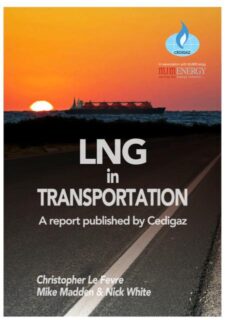Energy Transition

The Netherlands to become the foremost North-Western European hydrogen hub
| Non Member | 750 € | |
| Member | FREE | Login |
This report shows how the Netherlands is advancing its journey towards becoming the foremost hydrogen hub in North-Western Europe (NWE). It contains two types of information: strategic information on the Dutch hydrogen vision and policy, and detailed information on what is going on in the field. Information is updated to July 2022 when Shell took final investment decision (FID) on Holland Hydrogen I with an initial capacity of 200 MW (picture of the cover page). This is an important milestone. Holland Hydrogen I is the first large-scale electrolyzer investment in the Netherlands. It will be Europe's largest renewable hydrogen plant when it starts operation in 2024.
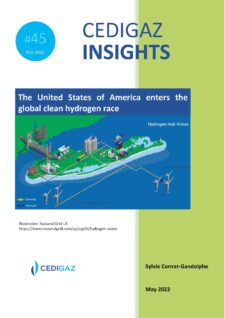
The United States of America enters the global clean hydrogen race
| Non Member | 750 € | |
| Member | FREE | Login |
The International Association Cedigaz has just released its hydrogen report: “The United States of America enters the global clean hydrogen race”, which assesses market developments, policies and prospects of the hydrogen industry in the United States. The report also provides data on US clean hydrogen production projects.

AUSTRALIA AT THE FOREFRONT OF DEVELOPING A HUGE HYDROGEN EXPORT INDUSTRY
| Non Member | 750 € | |
| Member | FREE | Login |
The Australian government released the National Hydrogen Strategy (the Strategy) in November 2019 and has continued to outline its support for hydrogen through the First Low-Emissions Technology Statement, released in September 2020. The government has stated its commitment to reducing Australia’s emissions through technology investment, rather than through carbon pricing, with the Technology Investment Roadmap a core element of its long-term emissions reduction strategy.
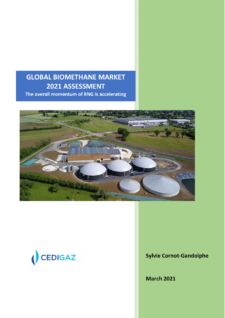
GLOBAL BIOMETHANE MARKET 2021 ASSESSMENT (Report and Database)
| Non Member | 1770 € | |
| Member | FREE | Login |
This report updates the 2019 CEDIGAZ’s comprehensive study on global biomethane (also known as renewable natural gas, RNG). It focuses on biogas upgrading and looks at key developments in the marketplace, policies, and major markets. Global RNG production reached 4 bcm in 2019, a doubling since 2015. There are now close to 1,000 biogas upgrading plants operating in the world. The market remains dominated by Europe (2.4 bcm), but the United States is catching up rapidly and, in fact, has become the world’s leading producer (1.1 bcm), ahead of Germany. In other regions, biomethane production is still limited (0.4 bcm collectively), but the market is taking off in Brazil, Canada, China and India. Recent years have seen significant shifts in terms of key sources of demand and market drivers. Hard-to-abate sectors (road transportation, shipping, heat) are becoming the focus of support policies, while cost reduction in wind and solar power generation makes the use of biomethane in the power sector less attractive, except for providing flexibility. RNG is more and more recognized for its key role in decarbonizing and bringing sustainability in the agriculture and waste sectors and is increasingly included in climate policies targeting these sectors.

GLOBAL BIOMETHANE MARKET 2021 ASSESSMENT (Report)
| Non Member | 990 € | |
| Member | FREE | Login |
This report updates the 2019 CEDIGAZ’s comprehensive study on global biomethane (also known as renewable natural gas, RNG). It focuses on biogas upgrading and looks at key developments in the marketplace, policies, and major markets. Global RNG production reached 4 bcm in 2019, a doubling since 2015. There are now close to 1,000 biogas upgrading plants operating in the world. The market remains dominated by Europe (2.4 bcm), but the United States is catching up rapidly and, in fact, has become the world’s leading producer (1.1 bcm), ahead of Germany. In other regions, biomethane production is still limited (0.4 bcm collectively), but the market is taking off in Brazil, Canada, China and India. Recent years have seen significant shifts in terms of key sources of demand and market drivers. Hard-to-abate sectors (road transportation, shipping, heat) are becoming the focus of support policies, while cost reduction in wind and solar power generation makes the use of biomethane in the power sector less attractive, except for providing flexibility. RNG is more and more recognized for its key role in decarbonizing and bringing sustainability in the agriculture and waste sectors and is increasingly included in climate policies targeting these sectors.
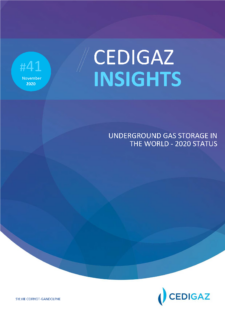
UNDERGROUND GAS STORAGE IN THE WORLD - 2020 STATUS
| Non Member | 150 € | |
| Member | FREE | Login |
The dramatic developments in gas markets in 2019-2020, with an acute oversupply situation due to the negative impact of the COVID-19 pandemic on demand and compounded by the massive increase of LNG supply from the US has stressed the fundamental importance of European Underground Gas Storage, assisted by Ukrainian UGS, to alleviate the imbalance of global gas markets. While until recently, UGS has mainly been developed in North America, Europe and the C.I.S., China is now on the fast lane for storage development. Russia, although the second global UGS capacity holder is still developing its storage infrastructure to serve both domestic and export markets.
This new report by CEDIGAZ provides an insightful review of storage activity in 4 key markets in 2020 and highlights the crucial role of UGS in balancing the global gas market as well as increasing security of gas supply in the context of rising geopolitical risks and trade tensions. The report also includes data on operating, under construction and planned facilities detailed by country.

Germany aims for leadership in green hydrogen technologies
| Non Member | 750 € | |
| Member | FREE | Login |

China Hydrogen Energy and Fuel Cell Industry: On the cusp of a major breakout
| Non Member | 750 € | |
| Member | FREE | Login |
Looking ahead, the Chinese hydrogen energy sector is on the cusp of a major breakout. In the context of the 14th Five-Year Plan (2021-2025), the central government is planning a new development path of the sector. The development of hydrogen energy is of great significance for China to achieve its energy transition, promote new industrial chains, and ensure the country’s energy independence. Draft policy documents consider the recognition of hydrogen as an energy source, the establishment of a national strategic plan and roadmap for the sector, and the set-up of rules, codes and standards for hydrogen energy.
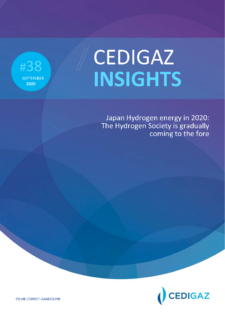
JAPAN HYDROGEN ENERGY IN 2020: THE HYDROGEN SOCIETY IS GRADUALLY COMING TO THE FORE
| Member | FREE | Login |
| Non Member | 750 € |

CLEAN HYDROGEN: BUILDING LARGE-SCALE SUPPLY CHAINS
| Non Member | 1680 € | |
| Member | FREE | Login |
Since 2017, governments from 18 countries have adopted national hydrogen strategies for deploying clean (low and zero carbon) hydrogen energy solutions. Leading companies around the world are proactively investing in clean hydrogen and related technologies. The transition to clean hydrogen would create a significant step-change in hydrogen production technology in terms of scale and costs, making clean hydrogen solutions more attractive not only for industry, but also in all other sectors. Clean hydrogen is an emerging market. It is a key lever for achieving deep decarbonisation, specifically in hard-to-abate sectors like transport. It can tackle various critical energy challenges, including facilitating the large-scale integration of intermittent renewables, enabling grid balancing and seasonal storage. It can also help to improve air quality and strengthen energy security. Its potential is immense and future developments depend on energy and environmental policies, cost reductions and competition with other low-carbon options.

A NEW ERA FOR CCUS DRIVEN BY CONTRASTED POLICIES AND BUSINESS MODELS: US AND EUROPEAN APPROACHES
| Non Member | 990 € | |
| Member | FREE | Login |
Following a period of low activity and weakening interest in recent years, CCUS is back into the limelight, especially in the US and in Europe, in the wake of the Paris agreement, boosted by a growing interest in hydrogen, rising carbon prices, new supporting policies and new business models.
This report provides an update on CCUS globally with a focus on Europe and the US, the two leading areas for this technology.
Contents:- Introduction: CCUS is back on policy makers’ agenda
- Growing policy attention and support for CCUS
- Global status of CCUS
- Barriers, challenges and required policies
- United States: Growing carbon capture & CO2-EOR industry
- Renewed interest and policy support in Europe
- Conclusion
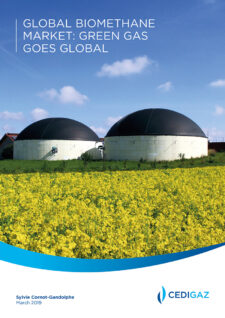
Global biomethane market: Green Gas Goes Global
| Member - unlimited online access | 500 € | Login |
| Non member - 5 licenses | 2500 € |
This report provides a detailed analysis of the booming biomethane market as governments around the world increasingly recognize the many benefits of renewable natural gas.
Since 2010, world biomethane production has increased exponentially, reaching three billion cubic meters in 2017 and there will soon be more than 1,000 biomethane production plants operating in thirty-four countries, up from 720 at year-end 2017.
For many years a European phenomenon, Green Gas is Going Global.
The report contains three parts:
- An overview of global biomethane production and markets, biogas upgrading plants, key drivers and future trends (region by region)
- Country reviews for forty countries in Europe, North America, Asia, Central & South America and Africa
- In-depth case studies on key developed and emerging biomethane markets, e.g. U.S., Canada, Brazil, Germany, France, China and India.
It complements the CEDIGAZ Global Biomethane Database
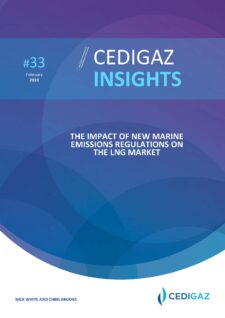
THE IMPACT OF NEW MARINE EMISSIONS REGULATIONS ON THE LNG MARKET
-
- What are the IMO emissions standards coming into force in 2020 and where do they apply?
- What are the possible options for ship owners?
- What are the opportunities for the LNG market?
- Current state of play – how is the industry planning for the 2020 regulations?
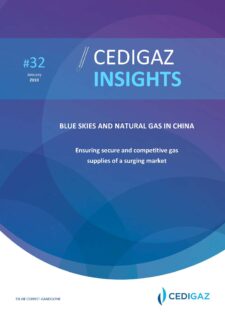
BLUE SKIES AND NATURAL GAS IN CHINA
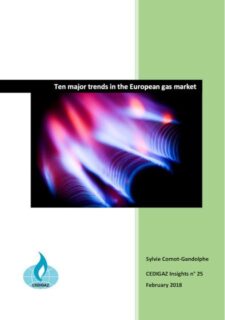
Ten major trends in the European gas market
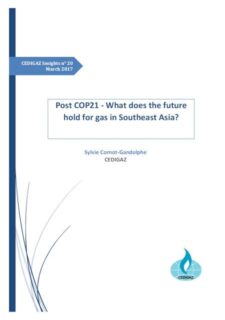
Post COP21 - What does the future hold for gas in Southeast Asia?
